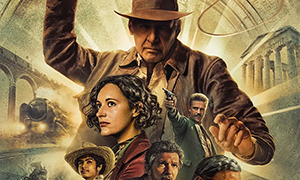Movie theatres didn’t spoil the female audience in September. I’ve lost track of all the new horror and action movies currently on offer (neither genre typically has much to offer female viewers). Our best options appear to be The Miracle Club and My Big Fat Greek Wedding 3. The former, starring the usually highly entertaining Maggie Smith, is disappointingly mediocre. The latter, written and directed by Nia Vardalos, a Canadian, isn’t nearly as much fun as 2002’s My Big Fat Greek Wedding. For these reasons, I’ve chosen to discuss a summer release: Indiana Jones and the Dial of Destiny. It boasts the Indy franchise’s most progressive lead female to date. Of all the Indy movies, this one has the most to offer the female audience.

Dial of Destiny is the fifth installment of the franchise and the only one not directed by Steven Spielberg. James Mangold directed the screenplay, which he co-wrote with Jez Butterworth, John-Henry Butterworth and David Koepp. It’s an entertaining blockbuster that’s true to the previous movies. It includes all the things we’ve come to expect from an Indy movie: archeology, treasure hunting, exotic shooting locations, a daring, arrogant hero, a Nazi villain, a score by John Williams, etc.
However, in Dial of Destiny Indy (Harrison Ford) shares the lead with a woman, his goddaughter Helena Shaw, played by 38-year-old Phoebe Waller-Bridge (creator of the TV series Fleabag). Confident Helena describes herself to Indy as intelligent, daring and self-sufficient—and she is. She’s courageous, pulling off the same types of stunts as her male co-star. She outsmarts men, repeatedly stands up to the film’s hero and is more adequately dressed than her predecessors (no lingerie this time). Also unusual for one of the franchise’s female characters is her short hair.
Comparing Helena to her predecessors shows how progressive she is. In Indiana Jones and the Temple of Doom (1984) Indy is paired romantically with vain and submissive Willie Scott (Kate Capshaw). The next two women to play opposite him, in Indiana Jones and the Last Crusade (1989) and Indiana Jones and the Kingdom of the Crystal Skull (2008) are villains: treacherous Elsa Schneider (Alison Doody) and Soviet agent Irina Spalko (Cate Blanchett) respectively. They’re both “bad women” who are ultimately punished (i.e. killed off). Before Dial of Destiny, most female filmgoers’ favourite Indy female character was likely Marion Ravenwood, played by Karen Allen, who has now appeared in three Indy movies.
In the first Indy movie, Raiders of the Lost Ark (1981), the hero is paired romantically with Marion. She could be tough and stand up to him, which was enjoyable since his treatment of women is regressive. In Raiders, Marion offers more to the female audience than her successors. In terms of lead females, the subsequent movies were steps backwards. Until Dial of Destiny, Marion was the franchise’s most progressive lead female.
At the end of the fourth movie, Kingdom of the Crystal Skull, Indy marries Marion. Given this union, we could reasonably expect her to join him on his newest adventure. But she doesn’t. Unfortunately, she gets just three disappointing minutes of screen time at the very end. She’s only there, in Indy’s kitchen, long enough to put away the groceries she brought him and kiss him. The likeliest reason she was excluded from the latest adventure is that she’s past her sexual prime—unforgivable for Hollywood actresses. Allen was given a grey wig for this part. Ford, on the other hand, was ‘de-aged’.
The filmmakers’ decision to reduce to insignificance Marion’s part merits attention. Allen is 71 years oldmaking her Ford’s junior by a decade. It’s worth mentioning because even though octogenarian Ford was deemed worthy of starring in yet another action-adventure film, his younger co-star wasn’t. Of course, most of the women paired with Indy were in their thirties.
The franchise has a history of pairing Ford with younger women, and they haven’t outgrown the habit. Both Allen and Capshaw are a decade younger than Ford. Doody was 23 when she played opposite 42-year-old Ford in Last Crusade. The oldest woman to play a leading role opposite him—other than Allen—was Blanchett, who was 39 when Kingdom of the Crystal Skull was released (Ford was 66). Waller-Bridge’s age corresponds to most Indy women’s (i.e. not past their sexual prime). However, now the age gap has jumped to 43 years—that’s hardly progress.
Excluding Marion wasn’t the only thing the filmmakers did that won’t endear the movie to female viewers. The first 22 minutes of Dial of Destiny elapse before a woman graces the screen and speaks (a woman with a bit role says a few words. Helena is introduced a few minutes later). For roughly the first 40 minutes no two women speak. Then CIA agent Mason (Shaunette Renée Wilson) says a few lines to a woman who is immediately killed. Women speak to each other for under one minute in this movie. Also, only two women get significant screen time (Helena and Mason)—and one of them is killed off.
When Indy asks Marion what she’s doing in his apartment—they’re separated—she says she’s putting away the groceries. It seems the filmmakers would have us believe this is all women in their 70s are good for. But we know otherwise. Marion shouldn’t be relegated to the kitchen simply because she’s past her sexual prime. Yes, Helena is a great addition—a worthy successor to Indiana Jones. However, the filmmakers need to update their views on older women. The female audience would be as openminded about Marion having another adventure as they are about Indy having one.
Indiana Jones and the Dial of Destiny is rated PG-13. It has a running time of 154 minutes and was released on June 30.
 Alline Cormier
Alline Cormier
Film analyst
See all articles by Alline Cormier



